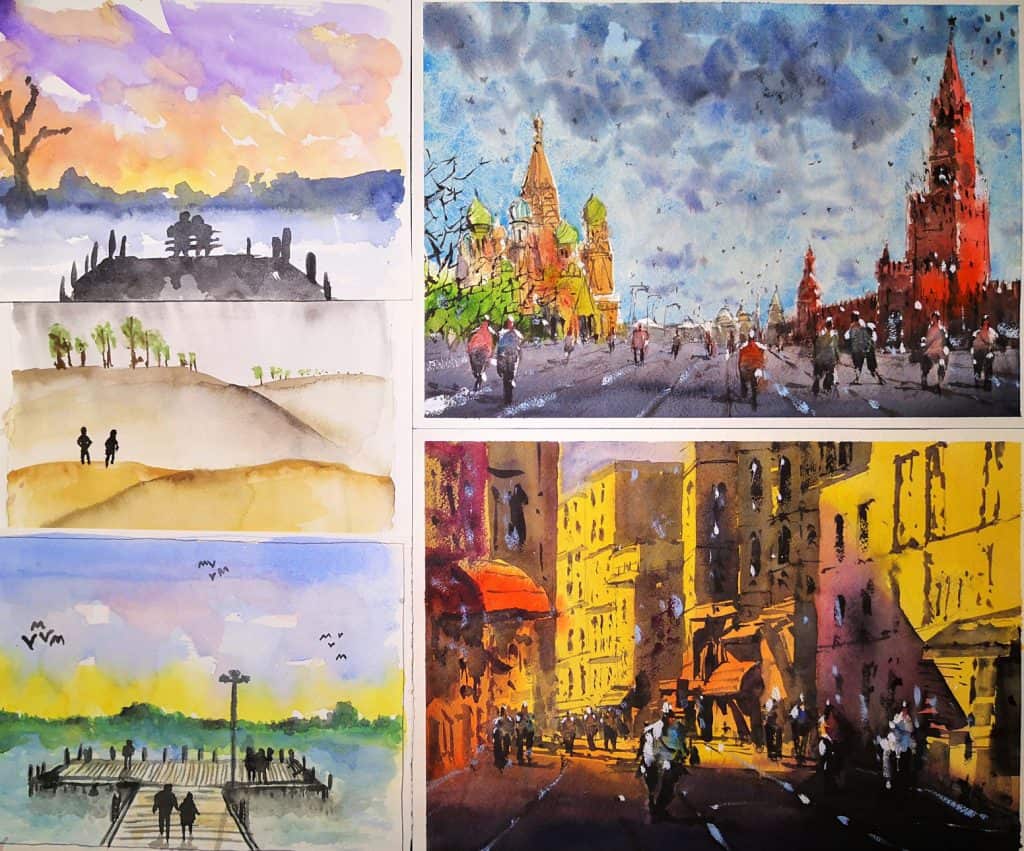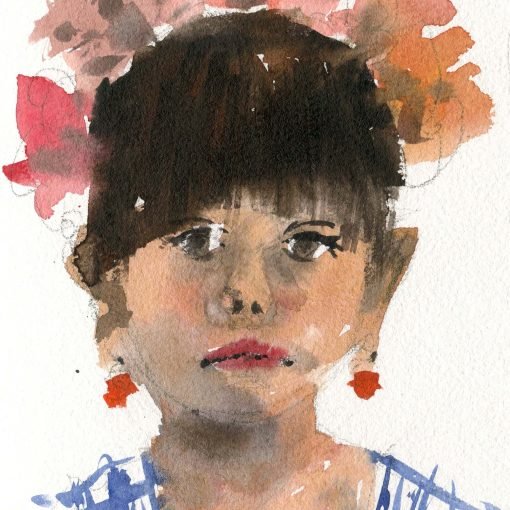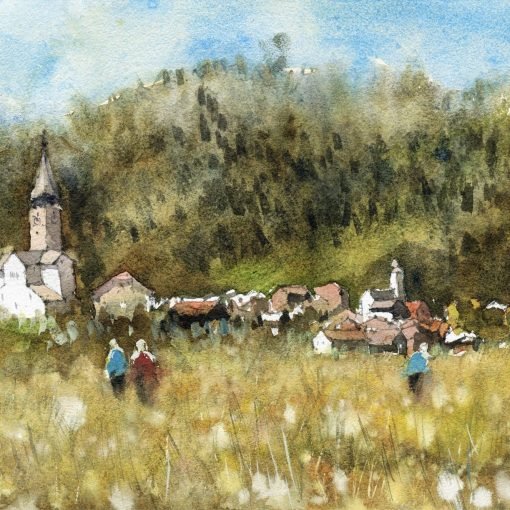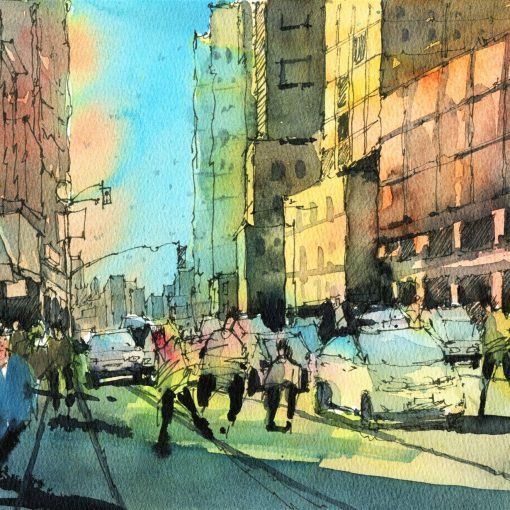Darren from Watercolour Mentor here.
I’ve made a lot of content on watercolour painting, the majority of it being instructional videos and classes. Today, I’d like to touch on something important – the mental aspect of the creative process. A bit of background about myself – I have a strong interest in self-development/mental health and have earned an honors degree in psychology. The overlap between psychology and art is an area I focused on when I started Watercolour Mentor and created videos for people online.
I’ve seen so many friends and beginner painters give up learning how to paint after a few tries that didn’t go as planned. What a shame! I hope that sharing how I handle mental roadblocks during the creative process will help others along their watercolour journey. An important thing to note is that I’m mainly writing for those who want to improve their art technically. Sometimes we have to remind ourselves that we all paint for different reasons, sometimes just to relax and wind down. If you’re not an artist, it will still be worthwhile to continue reading as the ideas below can be applied to other areas.
Carol Dweck’s theory of Growth and Fixed Mindset has been popularised since the early 2000s (there’s a short article on fs.blog if you want to learn more). In the context of creating art, having a fixed mindset is thinking that your artistic abilities are innate, something that you can’t influence.
Having a growth mindset is thinking that your artistic abilities can be developed with effort. A growth mindset makes you ‘stretch’ yourself and keep on when building your painting skills, even when your art doesn’t turn out how you intended – because you know that it takes time and that you’ll get there eventually. We should work on building a ‘growth’ mindset when it comes to creating art, as this drives us forward and builds resilience when we experience setbacks.

We see it all the time when someone showcases their amazing artwork. Comments praising the artist’s ‘talent’ flood in. We assume that they are and have always been, naturally good at art. Although these comments can stir up all kinds of reactions, most are mostly intended as a compliment and nothing more. But we have to ask ourselves: how often do we look into all the work an artist had to put in to get to that point? We often don’t see the years of practice, trial and error an artist had to put in, the failures and repeated effort that led them to be able to create largely appreciated works.
In my personal art journey, I didn’t get to where I am now overnight. It’s taken 6 years of on and off painting practice. In fact, it’s only been in the last year or so that I’ve set myself goals to paint each week and to try different subjects. There are times where I don’t even feel like painting, but I do it anyway and find myself enjoying it halfway through. Even then, it’s not always a linear road to progression – I’ve had years where felt I made no improvement at all! I’ll talk more about how I changed the way I practiced and actively sought constructive feedback in another post.
“We thought of life by analogy with a journey, a pilgrimage, which had a serious purpose at the end, and the thing was to get to that end, success or whatever it is, maybe heaven after you’re dead. But we missed the point the whole way along. It was a musical thing and you were supposed to sing or to dance while the music was being played.”
– Alan Watts
There’s a long road ahead of me and there’s so much I would like to learn, but checking on my progress over the years, I can see improvements and always take time to remind myself of the successes along the way. Sometimes it’s taking some time to recognize paintings that I have been proud of, a compliment from a stranger, the odd painting sold. Here is an example of my progress from 2015 – 2021:

As an artist, there are periods where you may create 10 paintings and only be happy with one. It’s been said a lot that we are our own worst critics. It’s difficult, but as artists, we have to learn to back ourselves and understand we will improve in time, and with consistent practice. Getting your work out there is a great way to get feedback and recognition, as often we judge our own work too harshly when in reality, others would be amazed at our progress. When you’re seeing your own artwork every day, it’s hard to notice small improvements. It’s the same thing when you plant a seed and watch it grow every day – barely perceptible.
“The journey of a thousand miles begins with one step.”
– Lao Tzu
So really, don’t be too hard on yourself. I hope you give yourself a chance to enjoy the learning process, and the act of creating art itself.
I created a short activity below. It should help you to develop a growth mindset and appreciate the small wins along the way. Over the next couple of weeks, try the following and remind yourself to apply it to real-life situations.
Picture yourself in these situations. Recognize and mentally note down your immediate thoughts. Think of an example of how you could interpret the situation with a ‘fixed mindset’ and a ‘growth mindset’:
Situation 1: You have been invited to join a painting challenge. This involves painting a subject that you’ve never painted before.
Examples:
Fixed Mindset – “I’m not talented enough to paint that.”
Growth Mindset – “This is a difficult subject, but I’ll give it a go and try to learn something new from it.”
Situation 2: You have been practicing painting each week, and make mistakes here and there.
Examples:
Fixed Mindset: “Painting isn’t for me. I should give up now as I’m never going to get there”
Growth Mindset: “Every time I paint and practice my techniques, I get a little better. It will click eventually if I keep at it”
Situation 3: You have decided to practice painting each week. However, you haven’t seen much progress in your art over the last two weeks.
Examples:
Fixed Mindset: “I’m not getting better, and everyone is more talented than me”
Growth Mindset: “I can see some improvements from my art over the past few months, and painting is fun anyway!”
Situation 4: An artist provides some tips and feedback to help me improve my artwork
Examples:
Fixed Mindset: “Geez, I didn’t want to hear that. What do they know, painting probably came easy for them anyway”
Growth Mindset: “They’ve probably been practicing a lot. Let me see how I can apply these tips to learn more and save time”
Situation 5: An artist posts an impressive painting in an online forum and receives praise.
Examples:
Fixed Mindset: “What a show-off! This is a beginner’s group.”
Growth Mindset: “Amazing artwork. Maybe I could ask for some tips and see what I can apply to my artwork”






8 thoughts on “Learning Watercolours: Mindset and Enjoying the Journey”
Very interesting, your progress is amazing and what you have written is totally true. The more I paint the better I got. I have tried to paint each day, but life gets in the way. I also know that I don’t draw as well as I used to, but I paint better than I used to. I’m realistic about my talent, I was a pretty good art teacher, but I would bet I’m better now! Just wish my drawing was better! The comments I get inspire me to keep on that journey. Have a sunny day!
Hi Carla, I’ve improved a lot more over the past year than in previous years by challenging myself to paint different subjects, more ‘difficult’ ones.. and spending more time studying the reference picture. Sometimes painting a small value sketch beforehand does wonders for the finished product. I get impatient with the drawing at times. Maybe you prefer a looser style now when painting/drawing? I think teaching is a great way to get better too! Thanks, have a good one 🙂
Very interesting comment. I have made similar experiences. I have drawn ever since I was a child.
Painting and drawing has been essential to my life and has helped me getting through difficult and stressful situations, although I had periods when I did not do art.
It takes some selfcontrol to draw or paint every day but it is worth it.
Practice always pays off.
I have experienced this fixed mindset: „What a show off, this is a beginners group „ but I have also learned a lot from others who were better and more experienced than I. My motto is : Never ever give up! Kunst ist Lebenselixir.
Hi Maya, yes I think we artists are lucky to have art as an outlet. Children love to create but it seems most people forget about it or say that don’t have time for such things as they grow older. But as you mentioned, there are so many mental health benefits. Even just the feeling of accomplishment when you finish a painting is worth it. I can understand/speak a little German, though I had to use Google Translate for that last word “Lebenselixir”! Will remember that one 🙂
An excellent article. It is common to overlook decades of work experience of other artists and thereby demean their struggles. It’s an unhappy term,
but pervasive online whining is also common when a new artist has not perfectly duplicated the art of their instructor with 20 plus years experience, and when a more advanced student posts a better developed painting than their own. This is akin to seeking a first job without prior experience, while
expecting a management position with a private office and a view.
The good news is that we can choose whether
to compare, be cranky and unrealistic,
or choose to accept our limitations as beginners and enjoy the journey. This comparison between static and growth mindsets is revelatory and an exceptional aid to artists.
Thanks Ann, I’m glad you enjoyed reading it. More to come, just have to find a nice time to sit down and write. I know what you mean, and nowadays I just take it as a general compliment, as most people mean well but are unaware of what they’re implying.
I guess we all look for shortcuts, and while there are some things that can speed up your progress like using good quality materials… there’s no substitute for consistent practice and reminding yourself that it takes time… and yes it’s like a trade even, surely you can’t be a good plumber after a year of being an apprentice!
They say the biggest hurdle between you and your goal is yourself… appreciate you reading this and sharing your thoughts.
I missed the Bhutan painting. Is it recorded so that I can watch it, I hope?
Thanks and Happy New Year.
Hey Anne, happy new year! Yes it’s available here: https://youtu.be/LUfQnff7HZI